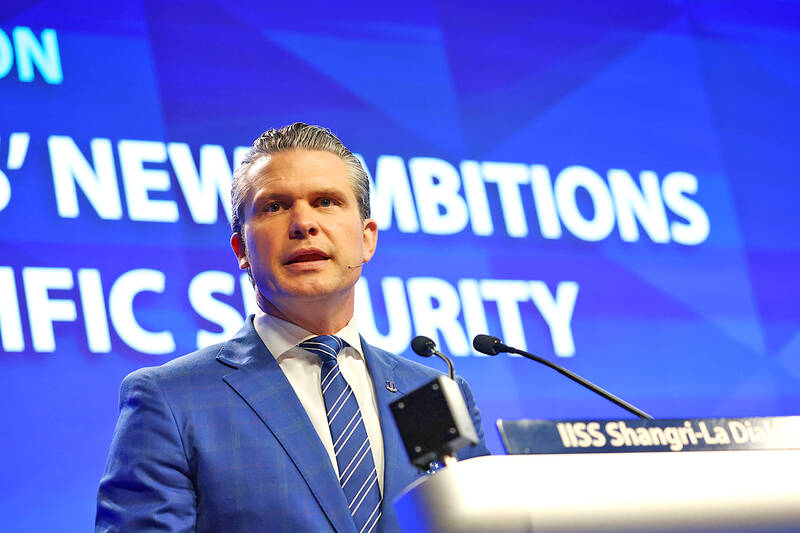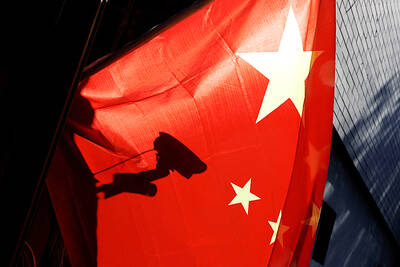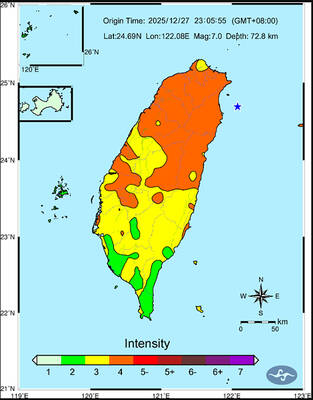US Secretary of Defense Pete Hegseth yesterday warned that any Chinese attempt to use force against Taiwan would have consequences far beyond the Indo-Pacific region, calling for coordinated regional efforts to deter aggression and ensure stability.
“Every day, China’s military harasses Taiwan. These activities have been paired with China’s rapid military modernization and buildup,” Hegseth said at the Shangri-La Dialogue security forum in Singapore.
“There’s no reason to sugarcoat it. The threat China poses is real, and it could be imminent,” Hegseth said, adding that “any attempt by communist China to conquer Taiwan would result in devastating consequences for the Indo-Pacific and the world.”

Photo: EPA-EFE
He also reiterated US President Donald Trump’s vow that “China will not invade [Taiwan] on his watch.”
China views Taiwan as its own territory and has vowed to “unify” the nation, by force if necessary. It has stepped up military and political pressure to assert those claims, including increasing the intensity of war games around Taiwan.
The government rejects China’s sovereignty claims, saying only Taiwanese can decide their future.
“It has to be clear to all that Beijing is credibly preparing to potentially use military force to alter the balance of power in the Indo-Pacific,” Hegseth said.
He reaffirmed Washington’s commitment to the Indo-Pacific region, which he described as “America’s priority theater,” and called for greater cooperation with Japan, the Philippines and other partners in the region to maintain peace and enhance deterrence.
The US is “reorienting toward deterring aggression by communist China” through improving its forward force posture, rebuilding its defense industrial bases, and helping allies and partners bolster their defense capabilities, Hegseth said.
While the US does not seek conflict with China, it would not allow Beijing to “dominate and control” the Indo-Pacific region, he said, calling out Beijing’s buildup in the South China Sea and use of cybercapabilities to “steal industrial technology” and “attack critical infrastructure.”
Hegseth urged US partners to increase military spending, adding that as Washington pivots to the Indo-Pacific region — leaving Europe to take more responsibility for its own defense — it also expects its Asian and Pacific partners to “upgrade” their militaries and act as “force multipliers.”
He also called out China for its ambitions in Latin America, particularly its efforts to increase its influence over the Panama Canal.
Hegseth urged countries in the region to increase defense spending to levels similar to the 5 percent of GDP European nations are pressed to contribute.
Following the speech, EU High Representative for Foreign Affairs and Security Policy Kaja Kallas pushed back at Hegseth’s comment that European countries should focus their defense efforts in their own region and leave the Indo-Pacific region more to the US.
With North Korean troops fighting for Russia and China supporting Moscow, European and Asian security were “very much interlinked,” she said.
Over the past few months, the Trump administration has taken a Patriot missile defense battalion out of the Indo-Pacific region to send it to the Middle East, a massive logistical operation that required more than 73 military cargo aircraft flights, and sent coast guard ships back to the US to help defend the US-Mexico border.
Hegseth was asked why the US pulled those resources if the Indo-Pacific region was its priority.
He did not answer directly, but said the shift of resources was necessary to defend against Houthi missile attacks from Yemen and to bolster protections against illegal immigration to the US.
At the same time, he stressed the need for allies and partners of the US to step up their own defense spending and preparations, saying that Washington was not interested in doing it alone.
“Ultimately a strong, resolute and capable network of allies and partners is our key strategic advantage,” he said. “China envies what we have together and it sees what we can collectively bring to bear on defense, but it’s up to all of us to ensure that we live up to that potential by investing.”
China usually sends its own minister of defense to the forum, but Chinese Minister of National Defense Dong Jun (董軍) did not attend this year.

A magnitude 7.0 earthquake struck off Yilan at 11:05pm yesterday, the Central Weather Administration (CWA) said. The epicenter was located at sea, about 32.3km east of Yilan County Hall, at a depth of 72.8km, CWA data showed There were no immediate reports of damage. The intensity of the quake, which gauges the actual effect of a seismic event, measured 4 in Yilan County area on Taiwan’s seven-tier intensity scale, the data showed. It measured 4 in other parts of eastern, northern and central Taiwan as well as Tainan, and 3 in Kaohsiung and Pingtung County, and 2 in Lienchiang and Penghu counties and 1

FOREIGN INTERFERENCE: Beijing would likely intensify public opinion warfare in next year’s local elections to prevent Lai from getting re-elected, the ‘Yomiuri Shimbun’ said Internal documents from a Chinese artificial intelligence (AI) company indicated that China has been using the technology to intervene in foreign elections, including propaganda targeting Taiwan’s local elections next year and presidential elections in 2028, a Japanese newspaper reported yesterday. The Institute of National Security of Vanderbilt University obtained nearly 400 pages of documents from GoLaxy, a company with ties to the Chinese government, and found evidence that it had apparently deployed sophisticated, AI-driven propaganda campaigns in Hong Kong and Taiwan to shape public opinion, the Yomiuri Shimbun reported. GoLaxy provides insights, situation analysis and public opinion-shaping technology by conducting network surveillance

‘POLITICAL GAME’: DPP lawmakers said the motion would not meet the legislative threshold needed, and accused the KMT and the TPP of trivializing the Constitution The Legislative Yuan yesterday approved a motion to initiate impeachment proceedings against President William Lai (賴清德), saying he had undermined Taiwan’s constitutional order and democracy. The motion was approved 61-50 by lawmakers from the main opposition Chinese Nationalist Party (KMT) and the smaller Taiwan People’s Party (TPP), who together hold a legislative majority. Under the motion, a roll call vote for impeachment would be held on May 19 next year, after various hearings are held and Lai is given the chance to defend himself. The move came after Lai on Monday last week did not promulgate an amendment passed by the legislature that

AFTERMATH: The Taipei City Government said it received 39 minor incident reports including gas leaks, water leaks and outages, and a damaged traffic signal A magnitude 7.0 earthquake struck off Taiwan’s northeastern coast late on Saturday, producing only two major aftershocks as of yesterday noon, the Central Weather Administration (CWA) said. The limited aftershocks contrast with last year’s major earthquake in Hualien County, as Saturday’s earthquake occurred at a greater depth in a subduction zone. Saturday’s earthquake struck at 11:05pm, with its hypocenter about 32.3km east of Yilan County Hall, at a depth of 72.8km. Shaking was felt in 17 administrative regions north of Tainan and in eastern Taiwan, reaching intensity level 4 on Taiwan’s seven-tier seismic scale, the CWA said. In Hualien, the